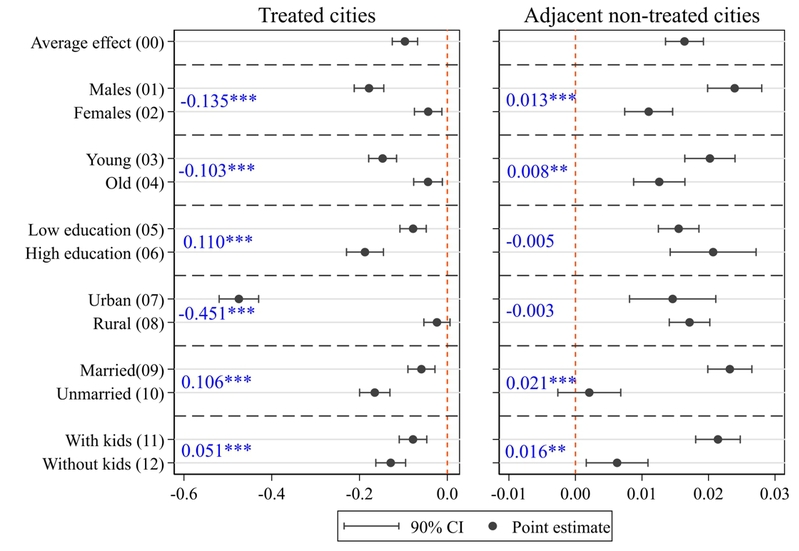Efficient labor reallocation is crucial for mitigating the negative economic impacts of environmental regulations. Previous studies focused on the effects of environmental regulations on labor reallocation within firms and across industries; however, few studies have evaluated inter-city labor reallocation. This study applied a spatial difference-in-difference model to investigate the geographical labor reallocations resulting from China’s Clean Air Action (CAA). We found that the CAA changed the distribution of labor across cities: it decreased employment within cities subject to the CAA (treated cities), while increasing employment in non-treated cities adjacent to treated cities (adjacent non-treated cities). Cooperation between cities with respect to CAA implementation helped alleviate regulation-related employment drops. A city-industry heterogeneity analysis shows that the CAA also reshaped the distribution of employment across industries within treated cities and adjacent non-treated cities. Moreover, individual-level heterogeneity analysis indicates that the impact of CAA on workers’ employment location choices varies significantly by demographic characteristics, including gender, age, marital status, education level, household type, and fertility status.
This study offers two novel contributions to the growing body of research on environmental regulation and labor demand. First, the study further explores the impact of environmental regulation on inter-city labor distribution. This differs from other studies focusing on the impact of environmental regulations on labor demand within firms or across industries. This study found that China’s CAA reduced employment in treated cities, but indirectly increased employment in neighboring untreated cities. This indicates that environmental regulations may lead to the redistribution of labor across cities, adding a new dimension to the research on environmental regulations and labor demand. Second, this paper explores the heterogeneous effects of environmental regulations on labor demand in different industries and at different individual levels. This helps identify who bears the costs of environmental regulations. In analyzing the long-term effects of environmental regulation on employment, cities often need to consider how to retain or attract talent, thereby stabilizing or enhancing economic growth. Since environmental regulations have varying effects on different industries and individuals, studying these heterogeneous impacts on employment can assist policymakers in determining which industries and individuals should receive primary support. This, in turn, can help retain or attract talent. Hence, the analysis of the heterogeneity of environmental regulation on employment has practical value. In addition, analyzing the heterogeneous impacts of environmental regulations on the employment location choices of different individuals also provides evidence for discussing environmental regulation and social equity.

Figure 9. The estimated results of individual-level heterogeneity.
Notes: Row (0) presents the estimation results from Equation (11), while rows (1) to (12) display the results from Equation (12), with a 90% confidence interval. The left panel shows the impact of the CAA on the employment willingness to move to treated cities, while the right panel illustrates the effect of the CAA on the employment willingness to move to neighboring non-treated cities. We categorize individuals with a bachelor’s degree or higher as the high education group and those with education below a bachelor’s degree as the low education group. People aged 35 and above are in the older age group; people under 35 are in the younger age group. The blue numbers represent inter-group differences calculated using the Wald test.
Environmental and Resource Economics (ERE) is the official journal of the European Association of Environmental and Resource Economists (EAERE). It is ranked ABS 3, FMS B, and ABDC A.
If you are interested in the research, please read the paper:
Li, Z., Cao, Y., Lai, A., & Wang, Q. (2025). Geospatial Labor Reallocation: The Impact of China’s Clean Air Action on Inter-City Labor Distribution. Environmental and Resource Economics. https://doi.org/10.1007/s10640-025-00996-w
A full version of this article could be viewed at:
https://link.springer.com/article/10.1007/s10640-025-00996-w

Nanjing University of Aeronautics and Astronautics
Copyright 2017 | All Rights Reserved with NUAA
